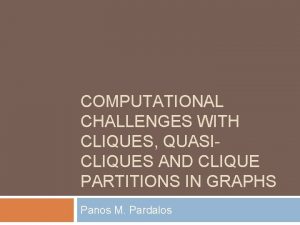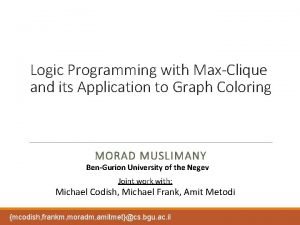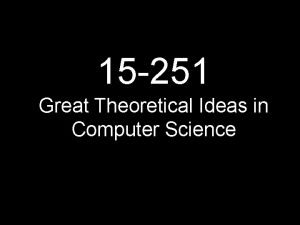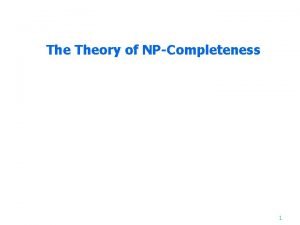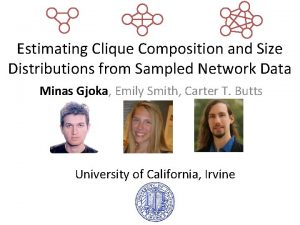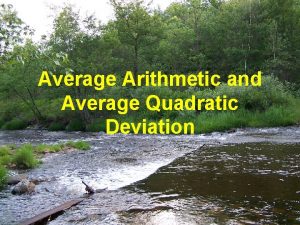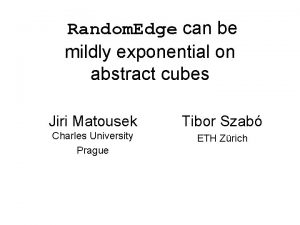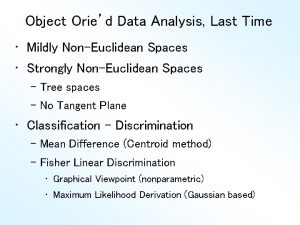mildly Large clique is hard on average for




![o Our target: Resolution [BIS 07]: [BGL 13]: [ABd. RLNR 18]: (the real large) o Our target: Resolution [BIS 07]: [BGL 13]: [ABd. RLNR 18]: (the real large)](https://slidetodoc.com/presentation_image_h2/0e5e5b6f4cb8bc5b1ab63d6f4430a67d/image-5.jpg)
![First result Theorem [P 19] For , any holds for resolution. , w. h. First result Theorem [P 19] For , any holds for resolution. , w. h.](https://slidetodoc.com/presentation_image_h2/0e5e5b6f4cb8bc5b1ab63d6f4430a67d/image-6.jpg)

![Ø Bottleneck counting (cf. [Pudlak 00]) • Start with a random r/2 -clique , Ø Bottleneck counting (cf. [Pudlak 00]) • Start with a random r/2 -clique ,](https://slidetodoc.com/presentation_image_h2/0e5e5b6f4cb8bc5b1ab63d6f4430a67d/image-8.jpg)




![The model (a-irregular resolution) [P 19] Input: CNF & a partition of variables If The model (a-irregular resolution) [P 19] Input: CNF & a partition of variables If](https://slidetodoc.com/presentation_image_h2/0e5e5b6f4cb8bc5b1ab63d6f4430a67d/image-13.jpg)
![Second result Theorem [P 19] On G(n, p) with the natural k-block-partition of variables, Second result Theorem [P 19] On G(n, p) with the natural k-block-partition of variables,](https://slidetodoc.com/presentation_image_h2/0e5e5b6f4cb8bc5b1ab63d6f4430a67d/image-14.jpg)



- Slides: 17

(mildly) Large clique is hard on average for resolution Shuo Pang Jan. 2020 BIRS

v v lower bound lbd for an intermediate model

k-Clique Given n-vertex graph G, is there a k(n)-clique in it? • Average case – random graphs G(n, p) Robust; hopefully gives clue about algorithmic hardness Proof complexity form Is k-clique hard on average for system P? • On average: Erdos-Renyi graph G(n, p)

threshold of being k-cliquefree …with parameter • On average: Erdos-Renyi graph G(n, p)
![o Our target Resolution BIS 07 BGL 13 ABd RLNR 18 the real large o Our target: Resolution [BIS 07]: [BGL 13]: [ABd. RLNR 18]: (the real large)](https://slidetodoc.com/presentation_image_h2/0e5e5b6f4cb8bc5b1ab63d6f4430a67d/image-5.jpg)
o Our target: Resolution [BIS 07]: [BGL 13]: [ABd. RLNR 18]: (the real large) for tree-like for regular resolution o Encoding: block ver. Captures ``internal’’ hardness (from G)
![First result Theorem P 19 For any holds for resolution w h First result Theorem [P 19] For , any holds for resolution. , w. h.](https://slidetodoc.com/presentation_image_h2/0e5e5b6f4cb8bc5b1ab63d6f4430a67d/image-6.jpg)
First result Theorem [P 19] For , any holds for resolution. , w. h. p. the -size lower bound

Proof sketch General strategy To show many clauses must appear Define a class of clauses that each one is `small’, while together `complete’ (Here, intuitively: clause that almost already reveals a partial-clique assignment say of size 0. 01 k. ) Definition. (Narrowness) Pigeon is narrow in R: vertices R allows to go is non (r, q)-neighbor-dense (r=0. 01 k). Definition. (Usefulness) A clause containing > 0. 01 k narrow or settled pigeons.
![Ø Bottleneck counting cf Pudlak 00 Start with a random r2 clique Ø Bottleneck counting (cf. [Pudlak 00]) • Start with a random r/2 -clique ,](https://slidetodoc.com/presentation_image_h2/0e5e5b6f4cb8bc5b1ab63d6f4430a67d/image-8.jpg)
Ø Bottleneck counting (cf. [Pudlak 00]) • Start with a random r/2 -clique , (An r/2 -subset of [k] at random; choose each place from comm. neighb. of previous) • Branch till some useful R appears. Claim I. One can always lead the process to some useful clause. (completeness) Claim II. Probability to each such clause is small. (smallness)

Summary o o The strategy is classic; Relatively simple pseudorandom properties.

Next goal: towards o The strategy is classic; …perhaps the same strategy, but finer pseudorandom properties. (``mostly-denseness’’) Theorem. [ABd. R+18] W. h. p. G is mostly-dense. For such G, -lbd on regular resolution holds.

From Regular to General Ø Regular resolution On any path, no variable queried more than once Ø Why regularity needed in that argument? (technical) Vars not reappear – probability can product (Markov-chain-like). Fails for general

From Regular to General A new model (M) ``Refines irregularity’’ Known separations Cook-Reckhow Input contains variable partition o Known regular-general separations: below M From literature: two CNF families [AJPU 02] o lbd for Clique: extends to M regular M general
![The model airregular resolution P 19 Input CNF a partition of variables If The model (a-irregular resolution) [P 19] Input: CNF & a partition of variables If](https://slidetodoc.com/presentation_image_h2/0e5e5b6f4cb8bc5b1ab63d6f4430a67d/image-13.jpg)
The model (a-irregular resolution) [P 19] Input: CNF & a partition of variables If a clause C touches > a-potion blocks (``block-width’’): Under C proof is regular, except on a-portion blocks (of vars). Ø Known separations: (naturally) fit in. Known power of general-over-regular is actually M-over-regular. almost- (Even for extremely small a)
![Second result Theorem P 19 On Gn p with the natural kblockpartition of variables Second result Theorem [P 19] On G(n, p) with the natural k-block-partition of variables,](https://slidetodoc.com/presentation_image_h2/0e5e5b6f4cb8bc5b1ab63d6f4430a67d/image-14.jpg)
Second result Theorem [P 19] On G(n, p) with the natural k-block-partition of variables, w. h. p. requires size for any -irregular resolution. constant

Proof sketch Ø Idea Regular result + self-reduction Useful C exists (as before) Find restriction (Proof simpler) consistent with C s. t. regular under C (using usefulness) (Instance remains hard) still quasi-random Apply regular result. Subtlety: key quasi-randomness likely not inherited. Fix: in short, relativize it.

Open problems v Weak lbd for PC v Regarding ``block-partitioned’’ model, is there possibile block-width vs size relation? (under reasonable restrictions)

Thank you
 Vegetable classifications
Vegetable classifications Mild dyslexia
Mild dyslexia Operant vs classical conditioning
Operant vs classical conditioning John donne compass poem
John donne compass poem Branches of motion
Branches of motion Hard times hard drive
Hard times hard drive Gravimetric analysis of calcium and hard water
Gravimetric analysis of calcium and hard water Have fun work hard make history
Have fun work hard make history Clique para editar
Clique para editar Clique computer science
Clique computer science Clique
Clique Max clique problem
Max clique problem Clique
Clique Clique
Clique Non-deterministic algorithm
Non-deterministic algorithm Clique para editar
Clique para editar Clique composition
Clique composition Clique sur la bonne réponse.
Clique sur la bonne réponse.










